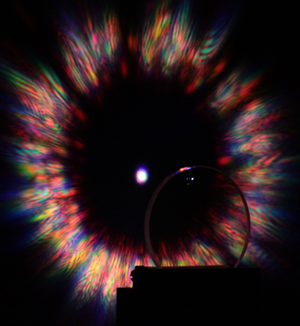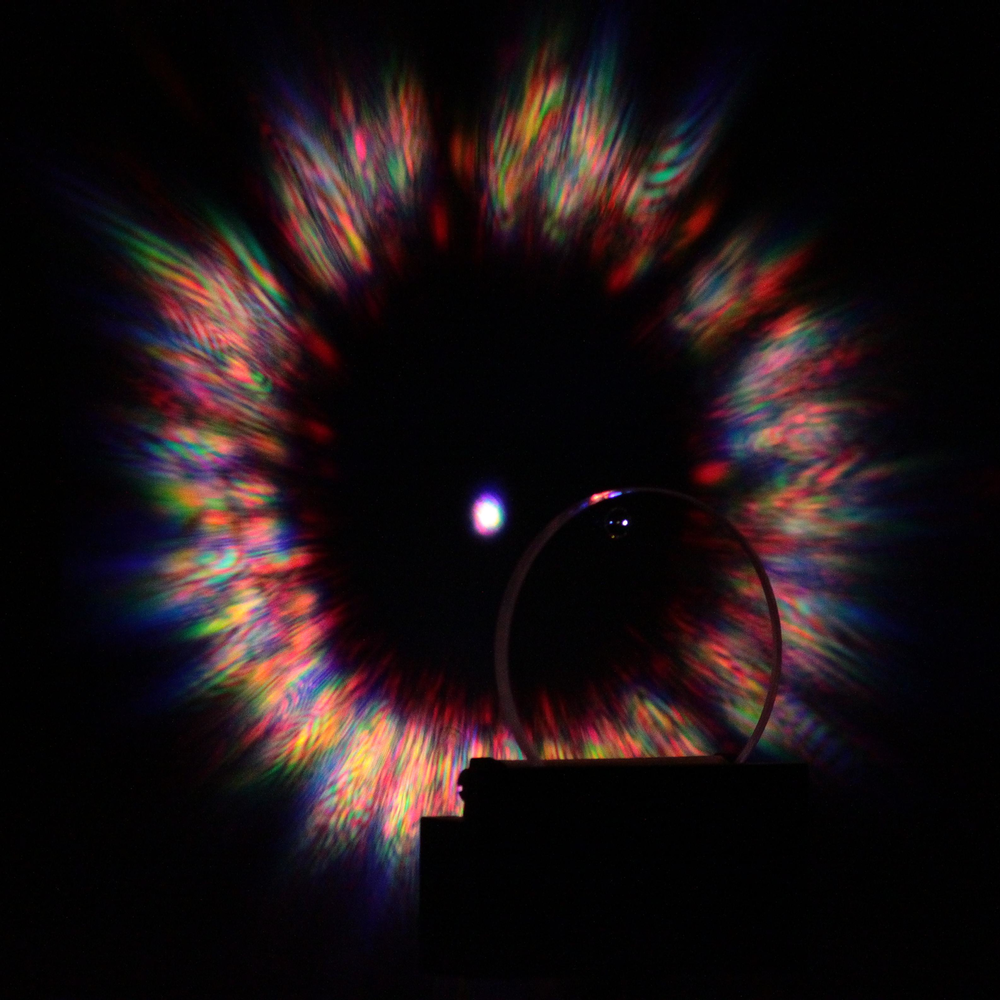Rainbow Pattern May Allow Laser Damage Monitoring
A spectacular sunburst of colored light produced as a laser beam bores into a solid surface could reveal information about the damage the light causes, according to a report in Physical Review Letters. The authors observed the rainbow pattern as they blasted a series of transparent materials such as glass and quartz with intense laser pulses. The team says that this effect, surprisingly overlooked until now, could offer a way of monitoring laser ablation, a technique used in fields as varied as dental surgery and art preservation.
Laser ablation uses ultrashort laser pulses, typically femtoseconds long, to blast away small amounts of material by highly localized heating. The technique is used, for example, for cleaning antiquities, performing eye surgery, and synthesizing microscopic devices and thin films. But no one has paid much attention to the scattered light, says Yi Liu of Ecole Polytechnique in Palaiseau, France. “People are mostly interested in the surface structures left after ablation, not the light itself.” Because Liu and his colleagues happened to use a lens with an unusually long focal length for their ablation experiments, they were able to see a colorful pattern in the light leaving the ablated material.
To investigate the pattern, the team fired hundreds of infrared laser pulses at blocks of transparent materials and recorded images of the light exiting from the back of each sample. After 10 pulses there was just a spot of bright white light where the beam passed straight through. (The infrared laser produced white light because of the complex interactions between light and matter, which generated a range of colors.) But as the researchers fired more laser pulses, a ring of bright, colored spots appeared around the central white one and gradually expanded. With further pulses, this ring divided into inner and outer ellipses and ultimately evolved into multicolored radial streaks reminiscent of a cat’s eye—a kind of splintered, circular rainbow. The researchers call this “ciliary white light” (CWL) because it resembles the so-called ciliary corona seen when one looks at a bright light at night. They saw the same effect for 14 different materials, including Pyrex glass, quartz, sapphire, and several polymers.
Liu and colleagues used an electron microscope to investigate the evolution of the conical crater formed in the material during the ablation process. Initially the crater was shallow and covered with parallel ripples with wavelengths of roughly 1 micron. But with more pulses, a regime with a different topography began to appear at the crater edges and gradually engulfed the ripples. This regime’s surface was uniformly covered with rod-like spikes about 100–200 nanometers across, separated by pits. Liu says that such structures are commonly observed in laser ablation, but researchers don’t yet understand why they form.
According to the team’s model, light scattering from the early ripples generated the initial ellipse of bright spots, a so-called diffraction pattern that forms whenever coherent light hits a periodic array of scatterers. As the ablation process progressed and the rod-covered topography began to cover the crater surface, light was also diffracted from these nearly regularly-spaced scatterers, but in a pattern of needles rather than spots. For needles, the “prism” effect that spreads white light into its component colors is more obvious than for spots. The researchers also explained the widening of the multicolored ring of ciliary white light: As the cone-shaped crater became deeper, its apex angle decreased, which widened the angle at which refracted light exited the material.
Liu and colleagues’ numerical simulations, based on scattering from the crater profiles they measured, led to a light pattern very similar to that seen experimentally. The CWL is directly analogous to the ciliary corona, which is thought to result from the scattering of light from small particles in the lens of the eye.
The team points out that in principle one could work back from the light pattern to deduce some properties of the surface that caused it, allowing the process to be followed in real time. Ben Truscott of the University of Bristol in the UK agrees. “It should be possible to determine the amount of material removed per pulse quite accurately from the rate at which the ring grows. This is much more awkward to measure by other means,” he says.
Stefan Nolte, of the University of Jena in Germany says that while the technique should prove useful, it would be challenging to calculate the precise structure of the ablated surface. Liu acknowledges that for a detailed reconstruction one would need to measure the amplitude and phase of the light, not just its intensity.
–Philip Ball
Philip Ball is a freelance science writer in London. His latest book is How Life Works (Picador, 2024).





